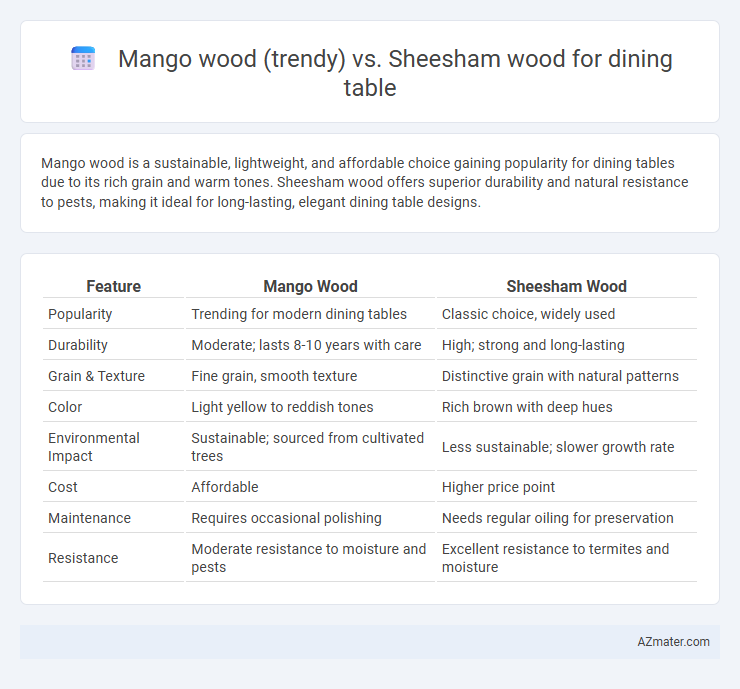Mango wood is a sustainable, lightweight, and affordable choice gaining popularity for dining tables due to its rich grain and warm tones. Sheesham wood offers superior durability and natural resistance to pests, making it ideal for long-lasting, elegant dining table designs.
Table of Comparison
| Feature | Mango Wood | Sheesham Wood |
|---|---|---|
| Popularity | Trending for modern dining tables | Classic choice, widely used |
| Durability | Moderate; lasts 8-10 years with care | High; strong and long-lasting |
| Grain & Texture | Fine grain, smooth texture | Distinctive grain with natural patterns |
| Color | Light yellow to reddish tones | Rich brown with deep hues |
| Environmental Impact | Sustainable; sourced from cultivated trees | Less sustainable; slower growth rate |
| Cost | Affordable | Higher price point |
| Maintenance | Requires occasional polishing | Needs regular oiling for preservation |
| Resistance | Moderate resistance to moisture and pests | Excellent resistance to termites and moisture |
Overview of Mango Wood and Sheesham Wood
Mango wood, known for its sustainable sourcing and distinctive grain patterns, offers a lightweight yet durable option for dining tables, showcasing a natural golden to reddish-brown hue that ages beautifully. Sheesham wood, also called Indian rosewood, is prized for its rich, dark brown color with characteristic streaks, providing exceptional hardness and resistance to decay, making it a long-lasting choice. Both woods highlight unique aesthetics and robust qualities, with mango wood favored for affordability and eco-friendliness, while sheesham wood is valued for its strength and luxurious appearance in dining furniture.
Current Trends in Mango Wood Dining Tables
Mango wood dining tables are gaining popularity due to their sustainable sourcing, unique grain patterns, and affordability compared to Sheesham wood. Current trends favor mango wood for its versatility and warm honey tones that complement modern and rustic interiors alike. While Sheesham remains valued for durability and rich color, mango wood sets new trends by blending eco-friendliness with stylish, contemporary designs.
Popularity of Sheesham Wood in Dining Furniture
Sheesham wood, known for its rich grain and durability, has gained significant popularity in dining furniture compared to Mango wood, which is lighter and less dense. The natural oils in Sheesham make it resistant to termite attacks and warping, enhancing its longevity in dining tables. This resilience, combined with its aesthetic appeal, drives consumer preference for Sheesham wood in high-quality dining furniture.
Durability Comparison: Mango Wood vs Sheesham Wood
Sheesham wood, known for its high density and natural oils, offers superior durability and resistance to warping and insect attacks compared to mango wood. Mango wood, while sustainable and eco-friendly, is softer and more prone to dents and scratches under heavy use. For long-lasting dining tables, Sheesham wood provides greater structural integrity and longevity.
Aesthetic Appeal: Color, Grain, and Finish
Mango wood dining tables feature a warm honey-yellow hue with rich, swirling grain patterns that create a rustic yet vibrant aesthetic, often enhanced by natural or matte finishes to highlight its unique texture. Sheesham wood offers deep reddish-brown tones with striking, dramatic grain contrasts and a smooth finish that exudes elegance and timeless sophistication. While mango wood brings a casual, lively charm to dining spaces, sheesham wood stands out for its luxurious and refined visual appeal.
Sustainability and Eco-Friendliness
Mango wood is highly sustainable due to its fast growth and use of surplus timber from mature mango trees no longer producing fruit, reducing deforestation impact. Sheesham wood, known for its durability, is often sourced from slow-growing trees, raising concerns about long-term sustainability and illegal logging. Choosing mango wood for dining tables supports eco-friendliness by utilizing a renewable resource with lower environmental costs compared to the more limited and slower-to-regenerate sheesham wood.
Price Comparison: Mango Wood vs Sheesham Wood Dining Tables
Mango wood dining tables are generally more affordable than Sheesham wood ones, with prices typically ranging from $200 to $600 depending on design and finish. Sheesham wood, known for its durability and rich grain, commands higher prices between $400 and $1,200 due to its hardness and longevity. Choosing mango wood offers a cost-effective option with good aesthetics, while Sheesham wood justifies its premium price through superior strength and natural resistance to wear.
Maintenance and Care Requirements
Mango wood requires regular oiling and cleaning with a damp cloth to maintain its smooth finish and prevent cracking, while Sheesham wood benefits from occasional polishing to preserve its natural oils and rich color. Both woods should be protected from prolonged exposure to moisture and direct sunlight to avoid warping or discoloration. Sheesham tends to be more resistant to pests and fungal attacks, reducing the frequency of deep maintenance compared to Mango wood.
Suitability for Modern and Traditional Interiors
Mango wood offers a light, uniform grain and warm honey tones, making it highly suitable for modern dining tables that emphasize minimalist and contemporary styles. Sheesham wood, known for its rich, dark brown hues and distinct grain patterns, aligns perfectly with traditional interiors, adding a touch of classic elegance and durability. While mango wood complements sleek and airy spaces, sheesham wood enhances rooms with ornate, vintage, or rustic decor themes.
Which Wood Should You Choose for Your Dining Table?
Mango wood offers a trendy, sustainable option for dining tables with its light color, smooth texture, and resistance to dents and scratches, making it ideal for modern interiors. Sheesham wood, known for its durability, rich grain patterns, and natural oils that enhance longevity and moisture resistance, suits traditional and rustic dining table designs. Choosing between mango wood and sheesham wood depends on your preference for contemporary aesthetics versus classic robustness and the importance of sustainability in your furniture selection.

Infographic: Mango wood (trend) vs Sheesham wood for Dining table
 azmater.com
azmater.com